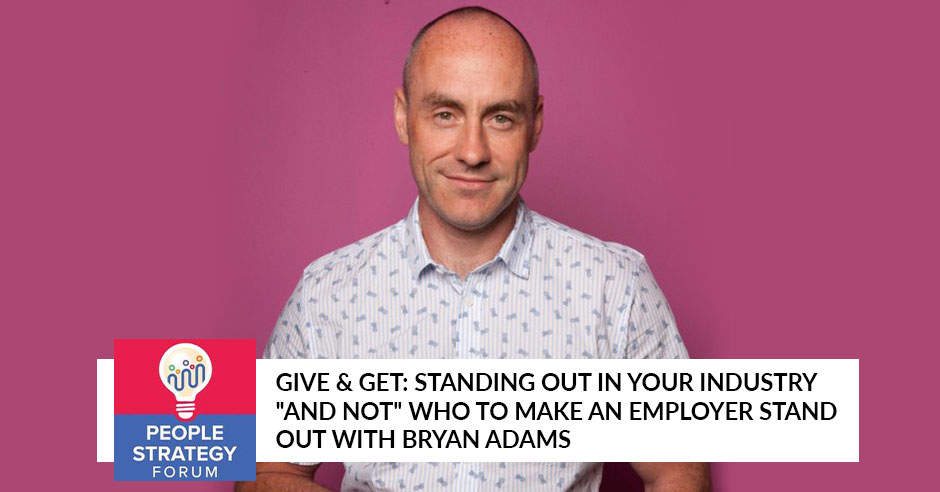Give & Get: Standing Out in Your Industry “and not” Who to make an employer stand out with Bryan

Creating a distinctive workplace where everyone can thrive professionally and discover their purpose is what every employer brand must strive to achieve. The roadmap on doing such a noble goal is presented by the Founder and CEO of PH.Creative, Bryan Adams. Speaking to the People Strategy Forum, he talks about his Give and Get Approach, which could help employer brands go beyond traditional methods and bring out the best in everyone. He explains the three aspects of building a healthy workplace culture and the three layers of an effective employer brand strategy. Bryan also reveals why environmental responsibility is essential in building an authentic brand and how artificial intelligence impacts the employer brand space.
—
Give & Get: Standing Out in Your Industry “and not” Who to make an employer stand out with Bryan
We’re a show that guides leaders and senior HR professionals on how to elevate the workforce overall. We believe that people are at the heart of successful organizations, and that team members, their well-being, rewards, and career development are all essential to a happy, healthy, and highly productive workforce. This show discusses the practical and effective leadership strategies for top executives, senior HR professionals, and talent managers overall. We have a number of hosts here.
First of all, I want to introduce Howard Nizewitz. He’s a seasoned veteran in compensation and HR practitioners in strategies like that. He’s been around for many years in this field. He has plenty of knowledge in that area so I’m happy to have him here. Sumit Singla is out of India. He comes with a deep pedigree working with many consultancies such as Deloitte, Aon, Accenture, GE, and so forth. He brings a lot of knowledge to multinational companies and so forth. I’m happy to have our team here. Unfortunately, Char is not able to join us. She is taking some time off, which is always good to take time off so I’m glad that she’s doing that.
I would like to introduce our expert contributor here. We’re going to be diving into the art of creating a distinctive workplace and an employer brand that attracts. Bryan Adams is an expert in this. He’s the Founder and CEO of Ph.Creative. Bryan stands at the forefront of employer branding wielding many years of expertise to architect the employer brands of titans like Apple, Nike, and American Airlines all across the globe. We’re fortunate to have him here. He’s also a bestselling author and an electrifying speaker. Bryan is very engaging. We’re going to talk a little bit about his book, which I’m looking forward to.
Bryan, your book is Give & Get Employer Branding: Repel the Many and Compel the Few with Impact, Purpose and Belonging. You have a very unique approach there. This is an interesting and very important approach to thinking about bringing the right people to the table. I’m desperately wanting to get into the discussion here. First, before we get there, please tell us a little bit about yourself. How did you get into this field? What gave you a passion for helping companies create their unique brand that attracts the best people?
First of all, thanks for having me on. It’s a pleasure to be here. I love talking about this. I appreciate the opportunity to get into the discussion. In March 2003, I started Ph.Creative. It was a spontaneous decision because I was poorly treated by my boss at the time. He belittled me in front of about 50 people. I went home and quietly decided never to go back and started Ph.Creative the next day. We started as a branding and marketing company. That’s my background. That’s what I did at school. It was fortune and dumb luck more than anything that after a few years, I’ve not been able to differentiate as a small company.
With 6,100,000 competitors in a very crowded space of marketing, we got a couple of customers who asked for those services, not to attract customers but people in the recruitment space. Very quickly, as I built a small team, we fell in love with the idea of the brand building on the other side of the house. It was many years ago that we started to focus. Shortly after that, we decided that this was all we were going to do.
From a position of naivety more than anything, you’ll see this as a running theme in my entire career. We wrote and planned out how we thought we should do employer branding rather than the lift and shift from marketing that the industry was used to. That’s how the Give & Get philosophy was born. We’ve stress-tested it a lot over the years but that’s where we started. That brings us to the present day.
One of the big things that’s impressive is some of the big names that you have in your portfolio. How did you brand yourself to be able to attract these titans?
Employer brand is not a very old industry. We were fortunate enough to be there at the beginning and we had something to say. From a branding background, I’ve always looked for an opportunity to swim in the opposite direction. I thought the lift and shift of marketing principles wasn’t the right solution. When we started putting out the message that employer branding shouldn’t be for the purpose of making you more attractive, it’s more of a smart filter so candidates and talent can make better decisions, it got the attention of the market. We gained a lot of momentum quickly with our case studies because it was counterintuitive at the time. It stood out. The results in the case studies were difficult to ignore. Very quickly, we got the attention of bigger brands.
Let’s dive in a little bit into your book. Tell me how the Give & Get approach differs from a traditional employer branding approach.
The crux of it is rather than just broadcast the strengths, benefits, and opportunities that you might find at an organization, we lean into the harsh realities, challenges, and adversities in full 360 in a bit to be more transparent and answer the burning questions that candidates have before they decide to apply for a role or not. Candidates on average will research 6 to 8 hours before interacting with your brand and apply for the role.
Part of the reason for that is they want to know the truth. They don’t quite believe all the shiny sunshine and rainbow statements that are on your career’s website and elsewhere. That’s why Glassdoor was bought for $1 billion because it had a little glimpse and an insight into not just what it’s like on a great day but what you might find typically. Our approach balances that.
It’s not just about transparency. It’s an opportunity to context the challenging adversities, sacrifices, and commitments that an employee might have to make. We all know they exist inside an organization. If you incorporate it into your brand story, what we found is you can put it into context and it’s the secret source to very quickly finding why people thrive and what it takes to thrive. You can start to build a story and a narrative of appreciation and acknowledgment for somebody thriving within less-than-perfect conditions so people feel more heard.
There are a number of benefits. Transparency and level-setting expectations are probably the most impactful for the candidate and employee. Controversially, we’ve got to remember that the employer brand at its core is a sharp strategy for an organization to turn culture into a competitive advantage. That means it needs to be perfectly aligned with what the organization needs in terms of behaviors and capabilities to move the organization forward. What we’ve found is the Give & Get approach is a perfect storm of all of those components.

Employer Brand: Transparency and level-setting expectations are probably the most impactful things for every job candidate and employee.
Were your clients reluctant at first to go down that road and expose some of the dark side of their organizations?
Some organizations are very brave. In some organizations, you have to approach it a slightly different way. Whenever we consult with an organization, we always are very keen to understand, “Why are you talking to us? What motivated you to reach out?” Usually, there is an urgent burning fire to put out. There’s always a people derivative. For some brands like Nike and very well-known brands, one of their biggest challenges is they get millions of applicants, most of whom are unqualified.
I’ve never met a TA leader who wants an abundance of more applicants. When we drill into discussing our approach, it makes perfect sense. You don’t want more applicants. You want more of the right ones. A smart filter makes sense. The headlines designed to get attention can make it sound scary but when it comes down to it, it makes a lot of sense. It’ll be fine.
You don’t want more applicants. You want more of the right ones. Share on XWhat are some of the strategies that you use for the authenticity of an employer sharing a bit of a dark side, the pros, and then also the cons? The cons are not necessarily cons for everyone. Some people want certain things. They’re looking for certain types of organizations. It’s finding the right fit overall. Tell us how you bring that out.
Let me give you an example. When we went into Apple and did all the research, essentially part of the role was to hold a mirror up and say, “This is what we found.” Across the board, it was very apparent that there’s not a lot of work-life balance in a lot of Apple. You have to leave your soul at the door and expect blood, sweat, and tears. You’ve got to do your best work. When you’ve done that, they’re going to give you more work to do and that needs to be great as well. It’s exactly what you said, Sam. What we found was that there were people there who were so obsessive about the brand, the legacy, the heritage, what Apple stood for, coding, or whatever they do on a day-to-day, that they thrived in those conditions
We’ve worked with Microsoft as well. On paper, they look like very similar organizations but I can tell you the culture couldn’t be more different. Being upfront with that and talking about what it’s like in the context of not why people join but why they stay and how they find purpose, impact, and belonging is the big unlock. Somebody will see a challenge and run away from it as fast as they can. Some will lean in because they’re excited to take it on.
When you first start engaging with an organization, it seems to be that you need to go through an analysis to determine those things that define their culture, those single words, and so forth. For instance, when I think of Apple, I often think of innovation. With Nike, I often think of competitiveness. What is the process that you use to understand what the culture is all about to be able to form your message?
It does come down to research and there are three aspects to it. There’s the leadership view to understand the direction of travel of the organization. What are we trying to build to solve? Where is the organization going? What do we need to build to help drive that forward? There’s the employee view. Often, that’s a mix of perception versus reality but understanding what it is like, what people feel about the experience, and what they think. There’s the market view. How do you differentiate and stand amongst your talented competitors?
The research needs to be representative of all areas of the business. We use a mix of qualitative and quantitative research techniques to get to the heart of the truth. We always say, “Data tells you what but people tell you why.” Look for the common thread right across the organization. There might be different experiences but what’s the red thread the way across? Distill that down, pull it together, and build a strategy.
Our goal is to perfectly align. If you imagine a Venn diagram in two circles, we want to overlap what people want and how they feel a source of purpose, impact, belonging, and what the organization needs to move forward. If we can create alignment, we know we’re in the right ballpark. That’s where the science meets the art. We try and craft something that bottles the magic and explains the tip of the iceberg in terms of the story we want to tell.
If we could dive into that a little bit more as far as what you believe are the critical elements of the employee value proposition that drives that attraction in that employer brand that is so critical.
When it comes down to it, the EVP is there to set expectations. It needs to be both authentic but also needs to be compelling, not attractive. The difference is substance. It needs to stand for something. There are three layers of employer brand strategy. First is the reputation. That’s designed to get attention. Next is the proposition, which is setting expectations. Finally, the talent experience. How does it show up authentically? How does that make people feel? It’s a combination of those three things.
Right at the top, when we’re thinking about reputation, what do we want our reputation to be to attract and retain the talent we need? From all of our research, we’ve found there are three types of organizations from a reputational perspective. 1) Culture, which the employer brand has traded on for many years. 2) Career catalyst. Is this a place that can accelerate my career? This used to be in third place but is arguably in the primary spot, citizenship.
People are making career decisions based on whether they can go to sleep at night with a clean conscience. Does this organization set out to leave the world better than we found it? Especially with Gen Z and Millennials, that’s the way the world is heading. It’s a combination of those ingredients. Finding what authentically aligns with the organization and out of that comes a message that compels the right people to join and stay.
People are making career decisions based on whether they can go to sleep at night with a clean conscience. Share on XThese are important elements you’re talking about, the career catalyst, citizenship, and so forth. Do you find that these are relatively consistent regardless of the demographics that make up an organization? Is there somewhat of a mix or change that you see?
It’s very easy for me to say this quickly and it sounds super simple. It’s not easy but it’s simple. What I’m talking about here, after nearly twenty years of doing the research and looking at many different organizations, are essentially the big buckets of human truths. Even in life and our career especially, we’re looking for a sense of purpose.
Does what I’m doing matter? Is it meaningful? Does my contribution make a difference, impact, and belonging? How does it feel? Do I feel safe? Do I feel like I belong? These are the foundational ingredients that make up every employer brand. Knowing and discovering from research what quantity of each is representative of your organization. That’s the work that you’ve got to do.
Sumit, I would love to hear your thoughts on this. We’re coming into the holidays of 2023, Christmas and Santa Claus. There are parts of the globe that have a perspective of this. In some areas, it has to do with gift giving, receiving, and the guy in the red suit. In other places, it’s not necessarily any of that. It’s not about the religious aspect but more about the symbolism or how Coca-Cola has the Santa that’s holding the can of Coke. Sumit, from your perspective of looking at these different types of employer brands around the globe, do you see that there’s a different perspective?
It’s yes and no. You can maybe transplant a brand in some ways. Thanks to Coca-Cola, Santa, and Hollywood movies that focus on the spirit of Christmas. I’m sure a young child in India could tell you about the spirit of giving and what Christmas stands for without having seen snow in their entire life. We would have things like fake snow or cotton disguised as snow in shopping malls. It’s probably not as much of a family bonding event or a festival where families get together. Somehow the spirit of Christmas starting from Charles Dickens and Scrooge is firmly there.
I’d like to believe that similarly, even for an employer brand, it could be a company that’s based say in the high mountains in Colorado. They can mimic the same brand for employees who are based in India as well. They need to figure out a way to get the employees to care about who the end customer is. If you can get them to relate to who are the people that you serve and what you stand for, it would help.
I was reading this book called Wired to Care and that brought out the inside beautifully. Simply outsourcing from location A to B is not going to create a whole lot of value unless people are able to relate to who the end customer is, what are their pain points, and how we solve them. That customer brand and employer brand go hand-in-hand. We are learning this here because we do have a lot of multinationals based in different parts of the world.
Bryan, a lot of things when you’re dealing with some differences across the globe, how different brands are perceived across the globe, and then the mutability of what’s going on in the world, the change, do you find that an employer brand needs to be retargeted on a more frequent basis than it has in the past?
What’s interesting about that is you’re right. A clear and confident employer brand will have a North Star and an element of consistency that will stand the test of time. With that confidence comes agility and the ability to flex and localize so you have something meaningful at a local level. Getting that balance for a global brand with a complex talent audience is essential. If you take the Christmas example, I was thinking about that.
If we agree that the North Star is this sense of togetherness and the value of giving, that relates to the vision or purpose of an organization, which is never going to change. The essence of that will show up all around the world but very differently and that’s okay. If I say to you, resilience and hard work, we can all identify what that means to us and share the same sentiment of being resilient and all of those things. The context and perspective might be different but that’s where authenticity comes in. It is the balance of those two things.
I often see organizations crafting their employer brand into some of their sales pitches. One I thought of a pretty good representation of this is Apple. They released their new version of the iPhone. One of the things with their brands or the message that they used to communicate was their mother nature proposal. They created a video of a lot of their executives sitting around the boardroom and they’re waiting for Mother Nature to come in to talk about how they are improving on their green report, how the iWatch is 100% carbon-free, and so forth as far as this manufacturer.
They were bringing elements of their employer brand in there by having some individuals talk from different departments or represent different departments and how they were moving the needle for the organization. I thought this is not only a compelling thing from the buyer’s perspective that they’re finding that this is a company that cares about environmental responsibility but also people that want to be affiliated with that messaging. Is this something you’re seeing more often as a viable strategy?
Yes. The world of employer branding is starting to emerge as a recognized means of amping up a brand with authenticity and being a point of difference. We’re in a society of brand identity. More people are choosing brands based on how they make them feel. It becomes enveloped in who they see themselves as. This idea of citizenship is certainly crossing the line from employer brand and is emerging as an extremely important aspect of brand equity that can give you an authentic message that people are looking for.
On the employer brand side, there’s plenty of evidence that suggests that consumer behavior is swayed by the ethics of an organization, its purpose, and what it stands for. When you see marketing dollars being swayed by that, then organizations tend to listen. We are working with a lot more CMOs than we used to and steering groups that are made up of a collection of C-Suite leaders because everybody’s bought into the value of the convergence, the message, what the brand stands for, how you treat your people, and how the people are making a difference to the world, not just their consumer audience.
Consumer behavior is swayed by the ethics of an organization. Share on XOne of the things that you mentioned as far as the messaging from the people is the talent experience that people are having in the role. What are the mechanisms that employers are using to communicate that experience as far as their brand and how people are experiencing that in their role?
This is super fascinating. I’m a lifelong student of story and story architecture. I’ve studied people like Robert McKay who’s the Yoder of story. He said, “If your brain was hardware, the story is the software we’ve run to make sense of the world,” which I love. That makes a lot of sense to me. The human-centric stories you’re able to tell about the employee experience can be very powerful. It’s going one step further. I would argue that we’re seeing a world of story-doing where we have to do things that make a difference and prove the things that we’re claiming.
If you say that you are an organization that believes in furthering humanity or making a difference in a community, you have to do initiatives that prove it. When you capture those moments and play them back to an audience, it’s extremely powerful. That’s one technique that a lot of brands and certainly a lot of our customers are using. The power of your employees standing up, saying something, and proving that they are making a difference resonates incredibly well, not just with a talented audience but with consumers as well.

Employer Brand: The power of your employees standing, saying something, and proving they are making a difference resonates incredibly, not just with a talent audience but with consumers as well.
From my perspective, the employer brand around the employee experience is becoming much more difficult to articulate. If we think about ten years ago, a lot of employers were saying, “The employee experience here is so cool. Work at the Googleplex and experience the coolness of our location.” We’re playing a bit of a different game. There is a lot of desire for a remote work environment. Beyond the social responsibility aspect, how are companies moving the needle here for those remote workers? How are they attracting them now that remote work is the norm?
The rules in the game haven’t changed. It’s just got a little bit harder. It means that we need to be a little bit more intentional and thoughtful. We need to go to more of an extreme to prove we mean what we say and capture the essence of what it’s like. They say you can swim naked until the tide goes. There are a lot of surface-level employer brands that claim a lot of things, certainly about the shiny offices, the green M&Ms, and the free lunches.
When you’ve got a fully remote workforce and you’re trying to galvanize people together, that takes something a lot more compelling than the peripheral shiny benefits. When the chips are down, it doesn’t make a difference. We’ve seen that coming out of COVID. We called it the Great Resignation. I call it the Great Epiphany. We all took two years to have a long hard think about what we want out of our careers and our lives. The game has changed forever, which means organizations have to craft an employer brand and an EVP that is meaningful. If we say that we care, we have to go to new lengths to prove it. It’s the same game. It’s just everybody’s leveled up and it’s harder to do.
One of the aspects that’s changed in the last decade or so is the fact that information is available freely. Your employer brand isn’t something that you can guard and protect. It’s probably almost organic in its growth. How does one coach lead us to ensure that they’re not making irresponsible statements or destroying the employer brand that’s taken years to build? A few examples, the founder of one of India’s largest IT companies said, “Youngsters should be working about 70 hours a week and participate in nation-building.”
LinkedIn went into meltdown because some people were saying, “No, he is being misinterpreted. He’s right.” There are folks like me who said, “This is ridiculous.” The entire industry has been struggling to make it sound less like a sweatshop but such statements don’t do it any favor. How does one help leaders realize what the brand is and embody it rather than existing on paper?
They say reputation can take years to build and seconds to fall. That’s a good example because when somebody says something like that, the reality is there’s probably some truth around it. They’ve probably seen the actual culture in that organization. The employer brand can’t be a piece of communication. It’s certainly not a one-and-done. It needs to have an element of conviction and this is where it needs to align with a brand business strategy. If you talk about work-life balance or quality of life, there has to be some element of commitment to that and it’s your job to prove it.
The employer brand can’t be a piece of communications. It needs to have an element of conviction and must align with business strategy. Share on XThe culture includes the weakest links where there is a department somewhere in the world in your organization where people have to work 70 hours a week. Unfortunately, that is part of your employer brand as well, whether you like it or not. It’s about taking responsibility for that and ultimately putting your money where your mouth is and seeing this through because it needs to be lived, breathed, championed, and trained. Your leaders and managers need to have the authority and conviction to live and breathe it with you. Otherwise, it will fall. That is a great example of that.
You were talking about creating the brand part of it, communicating it, and creating the story around it. How do we design good measures to see whether the employer brand is effective or not? One of the most common ones I’ve seen is the number of applicants per job that you post before and after a re-brand exercise, which I heard you say is a bad idea. It seems easy to measure. What are some of the effective ideas we could use?
Interestingly enough, 40% of employer brand leaders will still cite an increase in applications as a success measure for employer brand. I couldn’t disagree more. There are two macro measures that I always start with. One is the percentage of valued applicants. How many applications out of 100 do you qualify as valuable to the organization? If you can get the overall volume down but the quality up such that you’re hiring at a rate that is acceptable with less admin, that’s a good idea and allowing people to make more informed decisions.
The second is how many of those people stay beyond the first six months because that gives you a good indication as to whether you’ve set expectations appropriately. When it comes to retention, similarly to the talent attraction side, rather than looking at the percentage from an attrition perspective, look at the regrettable loss. How many people are you leaving that you would re-hire? How many people are leaving that you don’t want to leave?
Beyond that, you can download an employer brand dashboard off the internet. I don’t recommend it but what you end up doing is measuring a whole host of things that nobody cares about. The trick is understanding what the organization already cares about. What is the people derivative? How can you contribute to the things that the organization cares about from a people perspective? Start measuring those things. It isn’t the most tangible answer but that is the smartest place to start in my experience.

Employer Brand: By determining what an organization cares about and what the people can contribute to it allows leaders to measure the success of an employer brand.
The stuff you said indicates what Airbnb was talking about after enabling remote work everywhere and unlimited PTO. They said they had two million or somewhere around that number of applicants. Valuable applicants make so much more sense. Thank you.
That brings up the next question of two million. These organizations bring in that much noise and then have to find out what are the valued candidates out of that. How is artificial intelligence impacting your area as a brand crafter? On the other side, how are our organizations crafting the message around artificial intelligence that is compelling to candidates?
I can talk about how we’re using artificial intelligence. The story of artificial intelligence is we’re right at the start of it and we’ve got a long way to go before this plays out so we understand how it’s impacting organizations. There’s a lot of transition and change. We use it to accelerate things like research distillation, check for bias, and have a greater reach into our research. Organizations are using it for efficiency purposes. We’re seeing transformation across the board there.
It certainly changed the hiring profile of most organizations on the planet. How organizations are telling the story of their digital transformation is certainly something we’re going to see for a while. Something that we’re not talking about enough is how artificial intelligence is changing the landscape of candidates, how candidates are using artificial intelligence to show up as their best bionic selves, and how our organization is gearing up to deal with a swathe of candidates who, by and large, have all used ChatGPT to spit out the best resume that’s perfectly aligned to the job description so they enter the process.
We’re still in its infancy and there’s a long way to go to see how it plays out sustainably. We’ve said it time and time again. It’s not the tools. It’s how you use the tools. If artificial intelligence allows us to create more space to remember that we’re human and connect with more resonance on an emotional level around what the brand stands for and how it might feel to be part of it, we’re not going to lose sight of what we’re all trying to achieve.
If artificial intelligence allows people to create more space to connect on an emotional level, no one will never lose sight of what they are trying to achieve. Share on XBryan, as we’re coming towards the top of the hour, there are a couple more critical things that I want to make sure that we pick your brain on. One is some of the common pitfalls that you typically see employers make in defining their brand. What are the things that employers should be careful about?
We’ve covered some of them. It’s the temptation to be the most attractive brand out there, overstate claims, and set expectations that can’t be met. That’s a very dangerous space to occupy. When you look around and you’re trying to beat your talent competitors in a very congested and sophisticated talent marketplace, the temptation is high. Quite often, you might have something attractive but then if you take that same statement and put it above all of your competitors, it’s relevant and appropriate to them.
Having the restraint to hold out for something that makes you unique so it needs to resonate but it needs to set you apart. That’s simple but not easy. Quite often, we see that as something that most organizations fall on. They’re the main things. I could tell you some horror stories and some fun stuff that we’ve seen but they’re typically the biggest mistakes.
Are there things that you would add to that list as far as the pain points or trends that are coming up as far as employer branding, things that people should be getting on their outlook?
I’ve talked about citizenship and having to dig deeper with a little bit more substance of the brand. The flip side to that is brands that are quick to jump on a bandwagon and voice a strong opinion that isn’t aligned with the DNA of their organization, on close inspection, don’t play out well. That’s something to resist in the attempt to try and be relevant in the moment. You’ve got to give a little bit more respect to your talent audience. People are smarter than that. They do the research. If it doesn’t smell right, you’ll be found out very quickly.
There are some elements where employees or candidates want certain companies to take a stance on something that is not necessarily aligned with their overall purpose or value. How should leaders respond to that to ensure that they’re quelling the dissatisfaction?
It’s setting out the guardrails and having the confidence to make those calls. If you care very deeply about something that’s closely aligned with your purpose, having the conviction to say something potentially controversial can go in your favor massively. Even if there is a risk of losing revenue or profits, you will get the respect you deserve because it’s aligned with what you believe in and stand for. If it isn’t, then you’re sticking your nose where it’s not wanted or warranted, and then you can find yourself in hot water.

Employer Brand: If you care deeply with something closely aligned to your purpose, you can say something about it with conviction and get the respect you deserve.
We are in a world where a brand being political or voicing an opinion that might impinge on profit or revenue is not heard. There is more peer pressure to have some conviction and it’s socially more acceptable than it’s ever been. You’re still in choppy, dicey water if you don’t know what you’re doing or you haven’t got the steel to stick to your conviction once you’ve started. Some brands have been caught out by voicing an opinion that doesn’t match their agendas and they can’t back up their claims or articulate why they’re in that particular argument.
It’s been a wonderful discussion. Do we have any questions there, Sumit?
I do have one question. In the economic uncertainty that’s all around the world, we probably cannot avoid layoffs for various reasons. How does a company preserve or protect its employer brand while having to let people go?
In the last few years, we’ve seen a litany of examples of how to do it and how not to do it. Honesty, dignity, and grace are the guardrails. I’m not a huge fan of Meta but I’ve got to respect how they handled their round of layoffs. You mentioned Airbnb. Their stock and brand equity went up after their layoff because of how they handled that. We’ve seen stories of people being fired with mass text messages and people feel horrifically bad about that for obvious reasons.
It plays into a thought where if you think about your talent audience, you have a lot of employees but if you’re an organization that’s going to be around for a while and you want to build a sustainable brand, the biggest talent audience is probably your alumni. If you think about it, they grow in seniority and influence. They can be incredibly powerful in terms of advocacy and ambassadorship if it’s harnessed and done right.
Every time you go through this and you don’t do it with dignity, respect, and grace, you’re putting that alumni community at risk. The best way to sustainably protect a reputation as an employer is to think about people even after they’ve left your organization. The challenge with alumni is it’s never on fire, it’s never burning, and it’s never an immediate urgent priority but it is the case to sustainable employer brand reputation.
Thank you for that, Bryan. A lot of great wisdom was shared for sure. A lot of our audience out there are saying, “Would Ph.Creative be interested in my size of organization? How can I learn more from Bryan?” How would you respond to that, Bryan?
I’m always prevalent on LinkedIn. Feel free to connect on LinkedIn. We run two different types of employer brand sprints so it’s a 2 to 3-week online learning experience with cohorts, live sessions, and plenty of video lessons, downloads, tools, and templates. That can be found on our website, which is Ph-Creative.com. Please do check that out. The Give & Get is available on Amazon and all good bookshops.
Thank you so much, Bryan, for being with us. This has been a great conversation and a huge amount of value. It’s going to be helpful for many of our audience. Thank you so much.
The pleasure is mine. Thanks for having me on.
Thanks for the insights.
Thank you all for reading. We’ll see you in the next episode. Take care.
Important Links
- Ph.Creative
- Give & Get Employer Branding: Repel the Many and Compel the Few with Impact, Purpose and Belonging
- Wired to Care
- Amazon – Give & Get Employer Branding
About Bryan Adams
 Bryan is the CEO and founder of Ph.Creative, a leading global employer branding agency that specializes in building world-class employer brand, EVP and talent engagement strategy for companies such as Apple, American Airlines, GVC and Blizzard Entertainment. With over 19 years of experience in the field, he is considered a prominent employer brand thought leader and his creative, unconventional and even controversial methodologies are said to regularly change the way people think about employer branding and EVP.
Bryan is the CEO and founder of Ph.Creative, a leading global employer branding agency that specializes in building world-class employer brand, EVP and talent engagement strategy for companies such as Apple, American Airlines, GVC and Blizzard Entertainment. With over 19 years of experience in the field, he is considered a prominent employer brand thought leader and his creative, unconventional and even controversial methodologies are said to regularly change the way people think about employer branding and EVP.




